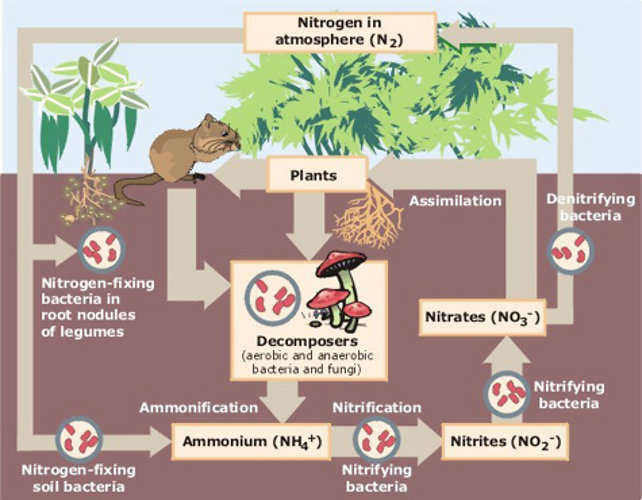Biofertilizeris a biotic constituent of specific microbial cells which when applied, stimulates plant growth by accelerating the rate of nutrient release through nitrogen fixation, phosphorus cycle, etc. Invitro cultures of specific microbes are selected for the preparation of biofertilizers to fulfill the specific nutrient requirements of different plants. Biofertilizer is categorized into different given below:
1-Nitrogen fixing
Free-living: Clostridium, Azotobacter, Nostoc, and Anabaena
Etc.
Symbiotic: Rhizobium, azollae, Anabaena etc.
Associative Symbiotic: Azospirillum.
2-Phosphorous solubilizing
Bacteria: Bacillus subtilis, Pseudomonas striata, Bacillus circulans etc.
Fungi: Aspergillus awamori, Penicillium sp etc.
3-Phosphorous mobilizing
Arbuscular mycorrhiza: Glomus sp., Acaulospora sp, Gigaspora sp & Sclerocystis sp.
Ectomycorrhiza: Laccaria sp., Boletus sp., Amanita sp.
Ericoid mycorrhizae: Pezizella ericae.
Orchid mycorrhiza: Rhizoctonia solani,
4-Biofertilizers for Micronutrients
Silicate and Zinc solubilizers: Bacillus sp.
5-Plant Growth Promoting Rhizobacteria
Pseudomonas: Pseudomonas fluorescens.

Biofertilizers Types
Rhizobium: Rhizobium is a nitrogen fixing bacteria that colonizes the root nodules of legumous plants and is an effective biofertilizers. They are referred as cross inoculation group for beingspecific to form root nodules in legumous plants and has seven genera. For all legumous plants it is applied as seed inoculant.
Azotobacter: Another nitrogen fixing bacteria inoculant that produces ample slime which aids in soil accretion e.g. A. chroococcum.
Azospirillum: Nitrogen fixing bacteria that colonizes the non-leguminous graminaceous plants rhizosphere and intercellular spaces of root cortex e.g. Azospirillum lipoferum,
A. brasilense, A. amazonense. Besides these have the ability to reduce nitrate, denitrify etc. Azospirillum is inoculated through seed, seedling root dip and soil application methods
Cyanobacteria: Free-living /symbiotic cyanobacteria is used as a biofertilizers for rice.
Azolla: Azolla is a free-floating water fern that fixes atmospheric nitrogen in association with cyanobacteria. It is used as a biofertilizer for wetland rice.
Phosphate solubilizing microorganism: Microorganisms such as Pseudomonas striata. Bacillus polymyxa, Penicillium, Aspergillus etc secretes organic acids that causes dissolution of bound phosphates in soil.
Arbuscular Mycorrhiza: Intracellular obligate fungal endosymbionts that possess vesicles for storage of nutrients and arbuscles for directing phosphorus, zinc and sulphur into the root system.
Silicate solubilizing bacteria: Some microbes are capable of dissolution silicates by secretion of organic acids like citric, oxalic acid etc. e.g. Bacillus sp.
Plant Growth Promoting Rhizobacteria: Such inoculants are either bioprotectants (suppresses plant disease), biofertilizers (improves nutrient acquisition) or biostimulants (phytohormone production). E.g. Pseudomonas and Bacillus species.
Benefits of Liquid Biofertilizer
-Long shelf life
-No contamination
-No loss of activity
-Easy documentation
-Cost effective
-Quality control protocols are easy and quick
-Better performance
-Easy to use
-Less dosage required
-High marketable profit
-High distribution potential
-High enzymatic activity [31-36]
-Benefits of Biofertilizers
-Fixing nutrient availability in soil
-Improves soil fertility
-Readily converts complex organic compounds into simple
-soluble forms
-Accelerates mineral uptake by plants
-Increases crop yield
-Stimulates plant growth
-Provide resistance against drought and soil-borne diseases
-Cost-effective
Uses of Biofertilizers
-Treatment of seed
-Root dipping of seedling
-Main field use
Limitations in Biofertilizer Technology
Though this technology is cost effective, environmental friendly but still there are numerous limitations that restricts its implementation.
-Technical limitations
-Use of less effective strains
-Absence of competent technical staff and many more.
